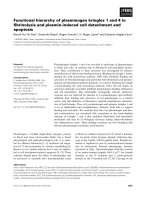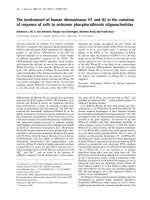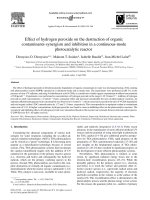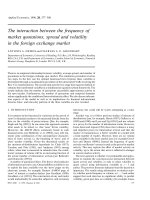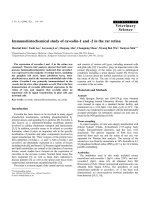The roles of histone deacetylases 1 and 2 in hepatocellular carcinoma
Bạn đang xem bản rút gọn của tài liệu. Xem và tải ngay bản đầy đủ của tài liệu tại đây (3.36 MB, 168 trang )
THE ROLES OF HISTONE DEACETYLASES 1 AND 2 IN
HEPATOCELLULAR CARCINOMA
LEUNG HO WING CAROL
NATIONAL UNIVERSITY OF SINGAPORE
2011
THE ROLES OF HISTONE DEACETYLASES 1 AND 2 IN
HEPATOCELLULAR CARCINOMA
LEUNG HO WING CAROL
(M.Sc., University of Oklahoma)
A THESIS SUBMITTED FOR THE DEGREE OF
DOCTOR OF PHILOSOPHY
DEPARTMENT OF PHYSIOLOGY
NATIONAL UNIVERSITY OF SINGAPORE
2011
Acknowledgements
I would like to thank my supervisor A/P Hooi Shing Chuan for his guidance
throughout my graduate studies, where I slowly learn to transform from a student to a
scientist. Thank you for your inspiration and understanding as a mentor and a boss. I
would also like to thank Mei Yee and Tan Jing from Dr. Yu Qiang’s lab at the
Genome Institute of Singapore for the help on my microarray.
I thank my lab mates Guodong, Guohua, Xiaojin, Jessica, and Tamil for making our
lab a pleasant place in which to work. I thank my former lab mates Bao Hua, Mirtha,
Colyn, Puei Nam, Yuhong, Koh Shiuan, and Hong Heng. Your friendship is the
greatest thing I take away from the lab. I also thank the administration staff at
Department of Physiology for facilitating the many procedures throughout my work
here as a student and a staff.
I want to thank my parents and brother for their support, my best friend Diana for
always lending a listening ear, and all my cell group sisters for all their love and
prayers. I also thank my kayaking kakis for their companionship on the many trips we
shared, and Amos for being the best adventure partner ever.
Lastly, I thank God for blessing me with all the above. In the midst of all that I have
gained and lost, You have always reminded me that Your Grace is sufficient for me.
i
CONTENTS
Table of contents i
List of Figures vi
List of Tables viii
Abbreviations ix
Summary xiv
Contents
1 CHAPTER 1 INTRODUCTION 2
1.1 Liver cancer 2
1.1.1 High occurrence and high mortality 2
1.1.2 Hepatocellular carcinoma (HCC) 2
1.2 Risk Factors for HCC 2
1.2.1 Hepatitis B and Hepatitis C viruses 2
1.2.2 Other risk factors 3
1.3 Current treatment of HCC and problems 4
1.3.1 Diagnosis and staging 4
1.3.2 Liver resection 4
1.3.3 Liver transplantation 5
1.3.4 Radiation therapy 6
1.3.5 Chemotherapy 6
1.4 Molecular mechanisms of HCC development 7
1.4.1 Pathway involved in cell survival 7
1.4.2 Pathways involved in cell proliferation 8
1.4.3 Apoptotic pathways 9
1.5 Epigenetic regulation in cancer 9
1.5.1 DNA methylation 9
1.5.2 MicroRNA 11
1.5.3 Histone modification 11
1.6 Histone acetyltransferases (HATs) 13
1.7 Histone deacetylase (HDAC) 13
1.7.1 HDAC family of proteins in mammals 13
1.7.2 HDACs can function in a protein complex 14
1.7.3 Regulation of transcription by HDACs 14
1.7.4 Regulation of HDACs 15
1.8 HDAC1 and 2 16
ii
1.8.1 Phylogenetic ancestry 16
1.8.2 Structure 16
1.8.3 Functions in normal cells development 17
1.9 Cooperative and distinct functions of HDAC1 and 2 18
1.9.1 Redundancy of HDAC1 and HDAC2 functions 18
1.9.2 Distinct functions of HDAC1 and HDAC2 19
1.10 Inhibition of HDAC 20
1.11 Biological effects and mechanisms of action of HDAC inhibitors 20
1.11.1 Apoptosis 20
1.11.2 Growth arrest 22
1.11.3 Mitotic disruption and autophagy 23
1.11.4 Anti-angiogenesis, anti-metastasis and invasion 24
1.11.5 Anti-tumor immunity 25
1.12 HDAC inhibitors in cancer therapy 26
1.12.1 Clinical trials 26
1.12.2 Synergism with other anti-cancer treatments 28
2 CHAPTER 2 AIMS 31
3 CHAPTER 3 MATERIALS & METHODS 34
3.1 Tissue Microarray 34
3.1.1 Tissue Samples 34
3.1.2 Immunohistochemistry 34
3.1.3 Scoring of Tissue Microarray 35
3.1.4 Statistical analysis 35
3.2 Cell lines and cell culture 36
3.2.1 Cell lines 36
3.2.2 Transient transfection 36
3.3 Western Blot 37
3.3.1 Protein extraction 37
3.3.2 Protein quantification 38
3.3.3 SDS PAGE and transfer 38
3.3.4 Immunodetection 38
3.3.5 Antibodies 39
3.3.6 Densitometry 39
3.4 Design of siRNA to knockdown HDAC1 and 2 40
3.5 Colony Formation Assay 45
3.6 WST-1 Cell Proliferation Assay 45
3.6.1 Cell plating 45
iii
3.6.2 WST-1 Assay 45
3.7 Cell cycle analysis 46
3.7.1 Collection of cells for fixation 46
3.7.2 Flow cytometry 46
3.8 Cloning of pcDNA-HDAC1 and pcDNA-HDAC2 plasmids 46
3.8.1 PCR to amplify DNA and DNA fragment purification by gel extraction
46
3.8.2 Ligation 47
3.8.3 Transformation 47
3.8.4 Plasmid miniprep 47
3.8.5 Verification of positive clones 48
3.8.6 Plasmid midiprep 48
3.8.7 Sequencing reaction 49
3.9 Site-directed mutagenesis 49
3.10 Immunoprecipitation 51
3.10.1 Cell lysis 51
3.10.2 Binding with antibodies and beads 51
3.10.3 Elution 51
3.11 HDAC Activity Assay 52
3.11.1 Extraction of nuclear protein 52
3.11.2 Fluorometric HDAC Activity Assay 52
3.12 RNA isolation 53
3.13 Microarray 53
3.14 Real-time RT-PCR 54
3.14.1 cDNA synthesis 54
3.14.2 Quantitative PCR 54
4 CHAPTER 4 RESULTS 57
4.1 HDAC1 and HDAC2 expression in human liver cancer 57
4.1.1 HDAC1 and 2 expression was increased in human hepatocellular
carcinoma protein extracts 57
4.1.2 HDAC1 and 2 expression was increased in human hepatocellular
carcinoma tissues by tissue microarray analysis 57
4.1.3 Correlation of HDAC1 and 2 expressions in hepatocellular carcinoma
tissues with clinicopathological parameters 60
4.1.4 Correlation of HDAC1 and 2 expressions with patient survival rates 64
4.1.5 Expressions of HDAC1 and 2 in various colon and liver cancer cell lines
67
4.2 Verification of efficiency and specificity of siRNA against HDAC1 and 2 . 67
iv
4.3 Effects of HDAC1 and 2 knockdown on cancer cells survival 69
4.3.1 Reduction of colony formation after knockdown of both HDAC1 and 2
in different cell lines 69
4.3.2 Reduction in cell proliferation over 6 days after knockdown of both
HDAC1 and 2 72
4.3.3 Cell cycle profile analysis showed increase in apoptosis in cells after
knockdown of HDAC1 and 2 72
4.3.4 Changes in expression of apoptotic proteins after knockdown of
HDAC1 and 2 79
4.4 Mechanisms for reduced cell survival after knockdown of HDAC1 and 2 79
4.4.1 Synergistic reduction in global HDAC activity after knockdown of
HDAC1 and 2 79
4.4.2 Construction and verification of HDAC1 and HDAC2 wildtype and
mutant expression plasmids 83
4.4.3 Effect of wildtype and mutant HDAC1 plasmid on rescuing effect of
HDAC1 and 2 knockdown 86
4.4.4 Protective effects of wildtype HDAC1 against PXD101-induced cell
death 90
4.5 Gene expression profiles of Hep3B cells after knockdown of HDAC1 or/and
HDAC2 and PXD101 treatment 94
4.5.1 Microarray analysis 94
4.5.2 Quantitative RT-PCR to validate selected genes 98
4.5.3 Western Blot to validate gene candidates 98
4.5.4 Effect of HDAC-regulated genes LOX and LOXL4 on colony formation
in HEP3B cells 98
4.5.5 Effect of HDAC-regulated gene GALR2 on colony formation in HEP3B
cells 104
5 CHAPTER 5 DISCUSSION 109
5.1 Upregulation of HDAC1 and HDAC2 in hepatocellular carcinoma (HCC)
109
5.2 Correlation between HDAC1 and HDAC2 expression with
clinicopathological parameters 110
5.2.1 Patient survival 110
5.2.2 Other parameters 112
5.3 Knockdown of HDAC1 and HDAC2 in the cells 113
5.3.1 Compensatory effects observed in cells 113
5.3.2 Compensatory effects not observed in clinical samples 114
5.4 Effects of knocking down HDAC1 and HDAC2 114
5.4.1 Reduction of colony formation and proliferation 114
5.4.2 Cell cycle profile showed increase in apoptosis 115
v
5.4.3 Significant effects observed only when both HDAC1 and HDAC2 are
knocked down together 117
5.5 Role of enzyme activity in function of HDAC1 and 2 118
5.5.1 Synergistic reduction of HDAC activity after HDAC1 and 2 knockdown
118
5.5.2 Effect of knocking down HDAC1 and 2 on colony formation is
dependent on enzymatic activity 119
5.5.3 Protective effect of HDAC1 against PXD101-induced apoptosis 120
5.6 Apparent discrepancy between clinical samples and in vitro data 121
5.7 Genes regulated by HDAC1 and HDAC2 122
5.7.1 Comparing HDAC inhibitor PXD101 with knocking down HDAC1 and
2 122
5.7.2 Genes differentially regulated when both HDAC1 and 2 were knocked
down together but not individually 122
5.7.3 Identification of possible mediators of the effect of HDAC1+2
knockdown on colony formation 123
5.8 Future studies 126
5.8.1 HDAC and the Wnt signaling pathway in HCC 126
5.8.2 Enzyme-independent functions of HDAC1 and HDAC2 127
5.8.3 Regulation of HDAC2 127
6 CHAPTER 6 CONCLUSIONS 129
7 REFERENCES 132
8 APPENDICES 148
vi
LIST OF FIGURES
Figure 3.1 Alignment of coding sequence of HDAC1 and HDAC2
41
Figure 3.2 HDAC1 mRNA and location of siRNA sequences
43
Figure 3.3 HDAC2 mRNA and location of siRNA sequences
44
Figure 4.1 Protein expression of HDAC1 and HDAC2 are upregulated in liver
tumor tissues compared to the matched adjacent normal
58
Figure 4.2 Densitometry to quantitate the fold increase in HDAC1 and HDAC2
59
Figure 4.3 Immunohistochemical analysis of hepatocellular carcinoma tissue
microarray
61
Figure 4.4 Kaplan-Meier curve to compare survival rate of patients with
different HDAC indices
65
Figure 4.5 Kaplan-Meier curve to compare survival rate of patients with a
HDAC index of less than or equal to 1, against those with an index of more
than 1
66
Figure 4.6 Comparison of HDAC1 and 2 protein expression among the various
colon and liver cancer cell lines
68
Figure 4.7 Quantitative real time RT-PCR to show efficiency and specificity of
HDAC1 and HDAC2 knock-down
60
Figure 4.8 Western blot to show specificity and efficiency of HDAC1 and
HDAC2 knockdown
71
Figure 4.9 Knockdown of protein expression of HDAC1 or/and HDAC2 in
HEP3B, HEPG2, PLC5, and HCT116 cells
73
Figure 4.10 Effect of knocking down HDAC1 or/and HDAC2 in HEP3B,
HEPG2, PLC5, and HCT116 cells
74
Figure 4.11 Quantification of colony formation in HEP3B
75
Figure 4.12 WST-1 assay showed that knocking down HDAC1 and 2 can
reduce cell growth over time
76
Figure 4.13 Cell cycle analysis of HEP3B cells
77
Figure 4.14 Quantification of the percentages of cells in each phase of the cell
cycle
78
Figure 4.15 Apoptosis occurs in Hep3B cells at 72h and 96h after knocking
down both HDAC1 and HDAC2
80
vii
Figure 4.16 Increase in apoptotic proteins after HDAC1 and 2 knockdown.
81
Figure 4.17 HDAC activity in HEP3B cells is synergistically reduced by
HDAC1 and 2 knockdown
82
Figure 4.18 In HCT116 p53-/- cells which did not have endogenous HDAC2,
knockdown of HDAC1 can dramatically reduce HDAC activity
84
Figure 4.19 HDAC plasmid cannot be overexpressed at protein level
85
Figure 4.20 Both HDAC1 and HDAC2 wildtype and mutant plasmids can be
overexpressed in HCT116 p53-/- cells
87
Figure 4.21 HDAC activity after overexpression of HDAC2 wildtype and
mutant plasmids in HCT116 p53-/- cells which lack endogenous full-length
HDAC2
88
Figure 4.22. Rescue experiment
89
Figure 4.23 Rescue of HDAC activity
91
Figure 4.24 Dose response of PXD101-induced apoptosis in HCT116 p53-/-
cells
92
Figure 4.25 Protective effect of HDAC1 overexpression against PXD-induced
death in HCT116 p53-/- cells
92
Figure 4.26 Effect of overexpressing wildtype and mutant HDAC1 and 2 on
global HDAC activity in HCT116 p53-/- cells
93
Figure 4.27 Microarray analysis to study effect of HDAC1 or/and HDAC2
knockdown on gene expression in HEP3B cell
95
Figure 4.28 Pie chart to show genes that were regulated at least 2 fold
compared to the control after siRNA or PXD101 treatment in Hep3B cells.
96
Figure 4.29 Validation of gene expression by quantitative real time RT-PCR
100
Figure 4.30 Validation of gene expression by Western blot
103
Figure 4.31 RT-PCR and Western blot to show efficiency of LOX and LOXL4
knockdown
105
Figure 4.32 Effect of knocking down LOX or LOXL4 in HEP3B cells
106
Figure 4.33 Effect of overexpressing GalR2 in HEP3B cells
107
viii
LIST OF TABLES
Table 1.1 HDAC inhibitors in clinical trials
26
Table 3.1 List of antibodies used in western blot
39
Table 3.2 Primer sequences used for generating HDAC1 and HDAC2 mutants
50
Table 3.3 Cycling parameters used for site-directed mutagenesis
50
Table 3.4 List of primers used in RT-PCR
55
Table 4.1 Summary of HDAC1 and 2 grading scores for HCC Tissue
Microarray samples
62
Table 4.2 Comparison of clinical parameters between matched samples that
have downregulated, no change, or upregulated HDAC1 and HDAC2
63
Table 4.3 Summary of univariate and multivariate cox regression analysis of
patient survival
67
Table 4.4. List of pathways with genes regulated by knocking down both
HDAC1 and 2 together but not individually
97
Table 4.5. Functions and fold change of genes selected for RT-PCR validation
99
Table 5.1 Significance of HDAC1 and HDAC2 expressions on patient survival
in the various cancers
111
ix
ABBREVIATIONS
Abl
V-abl Abelson murine leukemia viral oncogene homolog
AFP
alpha fetoprotein
AML
acute myeloid leukemia
APC
Adenomatous polyposis coli
ATM
ataxia telangiectasia mutated
Bax
Bcl-2 associated x protein
Bcl
B-cell lymphoma
Bcr
break point cluster region
BH3
Bcl-2 homology domain 3
Bid
BH3 interacting domain death agonist
Bmf
Bcl-2 modifying factor
BSA
bovine serum albumin
CBHA
m-carboxy cinnamic acid bishydroxamic acid
CCL
chronic lymphocytic leukemia
CDK
cyclin-dependent kinase
cDNA
complementary DNA
CK
casein kinase
CPS
counts per second
CRS
cutaneous radiation syndrome
CTCL
cutaneous T-cell lymphoma
CXCR
C-X-C motif receptor
DEPC
diethyl pyrocarbonate
DLBCL
diffuse large B-cell lymphoma
x
DMSO
dimethyl sulfoxide
DNA
deoxyribonucleic acid
DNMT
DNA methyltransferase
dNTP
Deoxyribonucleotide triphosphate
DR
death receptor
DTT
dithioreitol
EDTA
ethylenediaminetetraacetic acid
ERK
extracellular signal-regulated kinase
FDA
Food and Drug Administration
FIH
factors inhibiting HIF
GADD
growth arrest and DNA damage
GSK-3
Glycogen synthase kinase 3
HAD
HDAC association domain
HAT
histone acetyltransferase
HBV
hepatitis B virus
HCC
hepatocellular carcinoma
HCV
hepatitis C virus
HDAC
histone deacetylase
HGF
hepatocyte growth factor
HHIP
Hedgehog-interacting protein
HIF
hypoxia inducible factor
HRP
horseradish peroxidase
IAP
inhibitor of apoptosis
IGF
insulin-like growth factor
xi
IgG
immunoglobulin G
IPTG
isopropyl-beta-D-thiogalactoside
LB
lysogeny broth
LEF
Lymphoid enhancer-binding factor
MAPK
mitogen activated protein kinase
MBD
methyl CpG binding domain
MEF
mouse embryonic fibroblast
Met
mesenchymal-epithelial transition factor
MHC
major histocompatibility complex
MICA
MHC class I polypeptide-related sequence A
MICB
MHC class I polypeptide-related sequence B
miRNA
micro RNA
MMP
matric metalloproteinase
MMTV
mouse mammary tumor virus
mRNA
messenger RNA
MTA
metastasis-associated protein
mTOR
mammalian target of rapamycin
NAD+
nicotinamide adenine dinucleotide
NKG
natural killer cell protein group
NLS
nuclear localization signal
NSCLC
non-small cell lung carcinoma
PBS
phosphate buffered saline
PBST
phosphate buffered saline-Tween
PCR
polymerase chain reaction
xii
PI
propidium iodide
PI3
phosphatidylinositol 3-kinase
PTEN
phsophatase and tensin homolog
pVHL
von Hippel-Lindau protein
Rb
retinoblastoma
RbAp
retinoblastoma-associated protein
RECK
reversion-inducing-cysteine-rich protein with kazal motifs
RNA
ribonucleic acid
ROS
reactive oxygen species
RPM
revolutions per minute
S1P
sphingosine-1-phosphate
SAHA
suberoylanilide hydroxamic acid
SDS
sodium deodecyl sulphate
SDS PAGE
SDS polyacrylamide gel electrophoresis
SHH
sonic hedgehog
siRNA
small interferring RNA
SIRT
sirtuin
SMAC
second mintochondria-derived activator of caspase
SMO
smoothened
SOC
super optimal broth
STAT
signal transducer and activator of transcription
TBE
tris-borate EDTA
TCF
T-cell factor
TGF
trasforming growth factor
xiii
TIMP
tissue inhibitor of metalloproteinase
TNF
tumor necrosis factor
TRAIL
TNF-related apoptosis-inducing ligand
TSA
Trichostatin
VEGF
vascular endothelial growth factor
VPA
valproic acid
xiv
SUMMARY
Liver cancer is a disease that is more prevalent in Asia than the rest of the
world. Of the various types of liver cancers, hepatocellular carcinoma (HCC) is the
most common. The development of HCC is a multi-step process. During this process,
the aberrant expression and activities of various genes contribute to the survival and
proliferation of tumor cells. One family of proteins that is known to suppress the
expression of tumor suppressor genes is histone deacetylase (HDAC). The inhibition
of HDACs, by means of various classes of drugs collectively known as HDAC
inhibitors, is currently being examined as a strategy to kill tumor cells.
In this study, we identified two members of the HDAC family to be highly
expressed in human HCC tissue. Both HDAC1 and HDAC2 were upregulated in the
HCC tumors compared to the matched non-tumor controls, and HDAC1 expression
was found to be correlated with poor prognosis in the patients. When both HDAC1
and 2 were silenced in HCC cell lines, there was reduced colony formation, reduced
proliferation, and increased apoptosis in the cells. These effects are attributed to the
enzymatic activities of these 2 proteins, which have a compensatory effect on each
other’s expressions and activities. In addition, we also examined the change in gene
expression profiles in HCC cells when HDAC1 and 2 were silenced individually and
together, in comparison to the use of HDAC inhibitor PXD101.
Together, these results established the critical roles of HDAC1 and 2 in the
survival and proliferation of HCC cells. We have also elicited their mechanism of
actions by demonstrating the importance of their enzymatic activity as well as the
compensatory effects on each other. Understanding these 2 members of the HDAC
family would have significant impact on the design and use of HDAC inhibitors in the
treatment of HCC.
1
CHAPTER 1
INTRODUCTION
2
CHAPTER 1 INTRODUCTION
1.1 Liver cancer
1.1.1 High occurrence and high mortality
Due to population aging and growth, cancer is fast becoming the leading cause
of death. Liver cancer is the 5
th
most common cancer worldwide, with an alarming
748,300 new cases and 695,900 cancer deaths in 2008 (Jemal et al., 2011). The
highest liver cancer rate is in East and Southeast Asia, with over half of the cases
worldwide occurring in China alone. Between 1988 to 2001, the 5-year survival rate
of liver cancer patient is only 8% in the United States and 5% in developing countries
(Chuang et al., 2009).
1.1.2 Hepatocellular carcinoma (HCC)
There are many forms of liver cancers with different histological types. These
include hepatocellular carcinoma, childhood hepatoblastoma, adult
cholangiocarcinoma which originates from the intrahepatic biliary ducts, and
angiosarcoma which originates from the intrahepatic blood vessels (Chuang et al.,
2009). Of these, hepatocellular carcinoma (HCC) is the most common, accounting for
85% to 90% of all primary liver cancers (El-Serag and Rudolph, 2007). It frequently
occurs in a liver with chronic hepatitis and cirrhosis, where many hepatocytes die and
there is invasion by inflammatory cells and fibrosis (Thorgeirsson and Grisham, 2002).
1.2 Risk Factors for HCC
1.2.1 Hepatitis B and Hepatitis C viruses
The dominant risk factor for HCC is infection by Hepatitis B virus (HBV) or
Hepatitis C virus (HCV). HBV infection is common in Asian countries excluding
3
Japan, which has more HCV-related cases. The virus can be transmitted from mother
to child or via sexual intercourse. There is a 5- to 15-fold increased risk of HCC for
HBV carriers compared to non-carriers (El-Serag and Rudolph, 2007).
The HBV is a double-stranded DNA containing virus that belongs to the
family Hepadnaviridae (Sanyal et al., 2010). It can cause necroinflammation of liver
cells, leading to cirrhosis. Hepatocytes will proliferate in order to regenerate the
damaged liver. This high turnover in hepatocytes could result in accumulation of
genetic mutations of the cells. Consequently, there will be increase in genetic changes,
chromosome rearrangement, as well as activation and inactivation of oncogenes and
tumor suppressor genes respectively (But et al., 2008). In the absence of cirrhosis, the
HBV can also integrate itself into the host’s genome, contributing to genomic
instability (Szabo et al., 2004). Also, HBV produces HBx protein that is able to
regulate expression of genes involved in cell proliferation, deregulate cell cycle
control, and interfere with DNA repair and apoptosis (Feitelson, 1999).
The HCV is a RNA-containing virus that belongs to the Hepacivirus genus of
the Flaviviridae family (Szabo et al., 2004). It is unable to integrate into the host
genome, but its core protein can enter the host cell and localize on the mitochondrial
membrane and endoplasmic reticulum. This promotes oxidative stress for the infected
cell. Signaling pathways will be activated to upregulate genes involved in cytokine
production and eventually inflammation, changes in apoptotic pathway and tumor
formation (Sheikh et al., 2008).
1.2.2 Other risk factors
Other than HBV and HCV infection, aflatoxin contamination of food is also a
major risk factor for HCC. It occurs commonly in Southeast Asia and China, where
there is improper storage of food such as cereals and peanuts. Aflatoxin is a
4
mycotoxin produced by the fungi Aspergillus flavus and Aspergillus parasiticus and is
carcinogenic (Chuang et al., 2009). Aflatoxin B1 can cause p53 mutation by G:C to
T:A transversions at the 3
rd
base in codon 249 of the gene (Greenblatt et al., 1994).
In addition, there is also evidence to suggest that alcohol drinking, smoking, obesity
and diabetes as possible risk factors for HCC (Chuang et al., 2009).
1.3 Current treatment of HCC and problems
1.3.1 Diagnosis and staging
Diagnosis of HCC is generally made by radiological imaging and measuring
serum Alpha Fetoprotein (AFP) level. If a liver mass is detected in a patient with
chronic hepatitis or cirrhosis, there is a high likelihood of HCC. Biopsy may or may
not be needed to proceed with assessment for treatment.
Tumor staging for HCC is done by tumor/node/metastasis (TNM) staging or
Okuda staging system (Lau and Lai, 2008). The TNM system classifies tumors based
on the size of the primary tumor (T), presence of lymph node metastasis (N), and
distant metastasis (M), but does not look at liver function. On the other hand, Okuda
staging system takes into account liver function such as presence of ascites, as well as
albumin and bilirubin levels in the blood (Okuda et al., 1985).
1.3.2 Liver resection
The primary therapy for HCC is surgical resection of the liver. However, only
10% to 30% of HCC patients are suitable for surgery at the time of diagnosis (Lau and
Lai, 2008). There are many criteria to satisfy before recommending surgery.
Unsuitable patients include those with tumors that are too large resulting in
insufficient hepatic remnant after surgery which may lead to subsequent liver failure,
multifocal tumors that are too extensive, and distant metastasis (Lau, 1997).
5
The major problem with liver resection as treatment for HCC is tumor
recurrence (Portolani et al., 2006). Recurrence could be due to either intrahepatic
dissemination of the primary tumor or de novo tumor development. Intrahepatic
dissemination is usually the cause, evident from the fact that the presence of satellite
nodules and microvascular invasion are the 2 main predictors for tumor recurrence
(Adachi et al., 1995; Nagasue et al., 1993). Such recurrence commonly takes place
within 3 years after surgery, and is characterized by multifocal and aggressive tumor
(Imamura et al., 2003). Repeated hepatectomy can be done to treat recurrent disease
with a 5-year survival of up to 50%, but re-recurrence rate is generally high (Itamoto
et al., 2007).
1.3.3 Liver transplantation
Orthotopic liver transplantation is the best therapy for HCC, provided there is
no macroscopic vascular invasion and metastasis. Not only does it remove the tumor
burden, it also treats the underlying liver disease that could lead to recurrence in the
patient. However, there are very limited number of organs available for transplant,
leading to prolonged waiting time which is associated with high dropout rates as the
disease progresses beyond selection criteria for transplant (Rahbari et al., 2011).
Living donor liver transplantation can increase the pool of available donors.
Nevertheless, there are many ethical issues to be considered given the donor
morbidity of up to 40% and mortality of 0.5% (Trotter et al., 2002). In addition, there
is a need for immunosuppression in patients receiving liver transplant. Two of such
immunosuppressive drugs, Cyclosporine and Tacrolimus, have raised controversy for
their use in HCC patients as they have been shown to have potential tumor-promoting
effects (Guba et al., 2004).
6
1.3.4 Radiation therapy
External beam radiation therapy is seldom used in HCC due to the low
tolerance of the non-tumorous portion of the liver. It takes 120 Gy to kill the tumor
cells in HCC while liver irradiation beyond 40 Gy can cause radiation-induced liver
disease (Lawrence et al., 1995). Therefore, selective intra-arterial radiotherapy (SIRT)
is used to deliver radioactive microspheres to the tumor internally. However, SIRT
can also cause complications such as postembolic syndrome, characterized by fatigue,
abdominal pain, and fever (Rahbari et al., 2011).
1.3.5 Chemotherapy
Systemic chemotherapy is used to treat patients with unresectable HCC.
Doxorubicin is widely used in these patients but the response rate is very low (less
than 20%) with no survival advantage (Lai et al., 1988). Other drugs such as
Tamoxifen and Somatostatin have also been tested in clinical trials but results are not
satisfactory. However, there has been some success in the clinical trial of the drug
Sorafenib in recent years. Sorafenib is an oral multikinase inhibitor that can block cell
proliferation and neoangiogionesis (Wilhelm et al., 2008). In a multicenter phase III
clinical trial on Sorafenib to treat 602 advanced HCC patients, the treatment group
demonstrated 31% reduction in the risk of death and a longer median survival of 10.6
months compared to 7.9 months in the placebo group (Llovet et al., 2008). The time
to progression (TTP) based on independent radiological review was 5.5 months for
patients treated with Sorafenib and 2.8 months for the control group. However, like
most chemotherapy drugs, there were adverse side effects associated with the use of
Sorafenib. These include diarrhea, fatigue, weight loss, and hand-foot skin reaction.
Although there was no death related with toxicity being described, there was drug
discontinuation in 15% of the patients due to the adverse effects.
7
1.4 Molecular mechanisms of HCC development
Just like many other types of cancer, the development of HCC is a multi-step
process. Vogelstein proposed that there must be at least 3 genomic hits for solid tumor
such as HCC to develop (Vogelstein and Kinzler, 2004). The risk factors mentioned
in previous sections can set the stage for hepatocarcinogenesis by causing the initial
damage to the liver. Additional genomic hits, in the form of mutations or epigenetic
regulation, can alter key genes in the cancer pathways, thus inducing the cell to
acquire malignant phenotype.
According to Hanahan and Weinberg, pathways disrupted in cancer can be
divided into 6 groups based on their functions: evading apoptosis, unlimited
replicative potential, self-sufficiency in growth signals, insensitivity to anti-growth
signals, angiogenesis, and tumor invasion and metastasis (Hanahan and Weinberg,
2000). Numerous pathways are affected due to molecular changes in
hepatocarcinogenesis.
1.4.1 Pathway involved in cell survival
The 2 major pathways that are responsible for HCC cell survival are the Wnt
and Hedgehog (Hh) signaling pathways.
Upon binding of the Wnt ligand to the membrane receptor Frizzled, a cascade
of events occurs. The axin/GSK-3/APC complex which normally promotes the
degradation of beta catenin in the cytoplasm will be inhibited, allowing beta-catenin
to now enter the nucleus to interact with the TCF/LEF family transcription factors.
This leads to the transcription of various oncogenes, such as c-myc, cyclin D, and
survivin, which are involved in cell survival.
8
Two important genes in the hedgehog signaling pathway, Sonic Hedgehog
(SHH) and smoothened (SMO), are found to be overexpressed in many cases of HCC.
This leads to the activation of the pathway (Lachenmayer et al., 2010). On the other
hand, a negative regulator of the pathway Hedgehog-interacting protein (HHIP) is
downregulated in many HCC cases by methylation and/or loss of heterozygosity.
1.4.2 Pathways involved in cell proliferation
The pathways contributing to HCC cell proliferation are mesenchymal-
epithelial transition factor (c-Met), insulin-like growth factor (IGF), Ras-mitogene
activated protein kinase (Ras-MAPK), and PI3/Akt/mTOR, pathways.
Hepatocyte growth factor (HGF) can activate the c-Met pathway which is
responsible for invasive growth in cancer, angiogenesis, proliferation and migration
(Villanueva et al., 2007). In HCC, upregulation of HGF in cirrhotic liver and c-Met
amplification and mutation has been reported.
In addition, the IGF pathway is also frequently activated in HCC (Villanueva
et al., 2007). The upregulation of IGF-1 and IGF-2 and silencing of IGF binding
proteins can lead to proliferation, as well as anti-apoptotic and invasive phenotype of
the cell. IGF signaling can also activate the downstream Ras-MAPK pathway.
The PI3/Akt/mTOR pathway is involved in numerous cellular processes such
as proliferation, cell cycle progression, tumor growth, angiogenesis, apoptosis and cell
differentiation. In HCC, poor prognosis has been associated with activated Akt, which
can be activated by IGF signaling (Schmitz et al., 2008). Mammalian target of
rapamycin (mTOR) can sense nutritional status and allow progression from G1 to S
phase of the cell cycle (Sabatini, 2006). Aberrant mTOR signaling is commonly found
in HCC.
